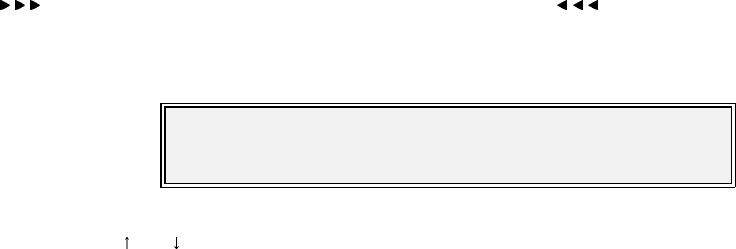
P300H P300 Series Modem Installation and Operating Handbook Page 40
1:Status 2:Change 3:Monitor 4:Info
5:Log 6:Test 7:Setup 8:Action 9:Help
Main Menu
6 MENU SYSTEM
6.1 INTRODUCTION
All configuration & monitoring features are accessed from the front panel via the menu system. Provided
an operator has an understanding of how the menu system works, there is no need to try and memorise
the menu structure itself, as selecting a single option (SETUP, INITIAL-CONFIG, explained later) will make
the unit prompt for all needed configuration parameters. The structure of the menu system is however
shown on the next few pages for reference.
THE 1 MINUTE GUIDE TO FRONT PANEL OPERATION
The main menu can be accessed from any display with the MAIN key. It is from this main menu that all
functions are selected.
Whenever the '
' or ` ' symbol appears it indicates that further information is available by pressing the UP
or DOWN key. This information is usually worth looking at (otherwise we wouldn’t have put it there !).
The NO key functions as a backstep/backspace key, both when entering numeric data, and when traversing
the menus. The YES key doubles as an enter key for numeric entries. Where a numeric entry requires many
digits (eg IF frequency), pressing YES after entering all significant digits fills the rest of the entry with zeroes,
pressing YES again, enters this value.
When the user is requested to select a configuration parameter, the last setting is always displayed in
[square brackets]. To select the same option again, just press the YES Key (ie you don’t have to reselect
the same option to get past the menu, just press YES)
Options displayed with a colon eg "1:Status" switch to another screen or subsequent menu but do not
affect operation. Options displayed with a equals sign eg "1=Off" change the configuration and may (if
changing a relevant parameter) affect the traffic. Reselecting a current option (or pressing YES to select
the current option) will never cause a traffic interruption.
When a unit is shipped (or if the non-volatile memory is cleared) it will have an blank configuration and
require the operator to use SETUP, INITIAL-CONFIG prior to allowing STATUS to be selected. This prompts
for all parameters required for a complete configuration.
Wherever possible menus state “(normal)” after the most common option. If in doubt, select the normal
option if there is one, it works every time !
After SETUP, INITIAL CONFIG has been performed once, minor changes to the configuration may be made
with the CHANGE option from the main menu. CHANGE allows parameters such as Tx & Rx service/data
rates, clocking, IF frequencies, and miscellaneous parameters to be set without going through the entire
SETUP process. If however you make a major change to the service (such as switching from Closed Net to
IBS) you might decide a quick run through SETUP, INITIAL CONFIG again (accepting the current values with
the YES key) will highlight any new parameters (with sensible defaults) that are relevant to this major change
of service.
Make use of the Rx=Tx option, it’s great, it cuts down configuration errors, and generally makes life easy.
At least read the note on Rx=Tx in section 6.7 on page 86 so you know what you are missing !


















